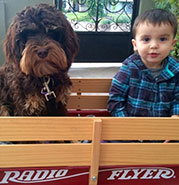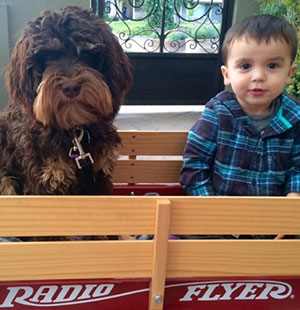

Photo by Calvin Tsai
Dr. Amy Goulart discovered by chance that some pet foods contain allergens that could endanger her toddler. She advocates that makers of pet edibles clearly label their products for allergens, as is done with food made for human consumption.
For most of us, dinner out or at a friend’s house is a relaxing way to spend an evening. In a hurry? Grab some takeout. But for people living with food allergies, potlucks, food trucks, birthday parties, buffets and barbecues are anything but easy, and often impossible.
Anything that’s eaten and, for some patients, anything even touched, could cause a potentially life-threatening allergic reaction. According to the advocacy group Food Allergy Research and Education, 15 million Americans have food allergies. Among those under age 18, about four out of 100 are affected, according to the U.S. Centers for Disease Control and Prevention. That's one kid in every classroom.
Food allergies aren't merely a nuisance. For tens of thousands of people in the United States alone, they're deadly serious. Allergic reactions to food are responsible for an estimated 30,000 emergency room visits and some 2,000 hospitalizations a year, according to statistics cited by the U.S. Food and Drug Administration. Severe reactions can kill.
Moreover, food allergies are becoming more common. A recent analysis by the CDC’s National Center for Health Statistics found that the prevalence of food allergies among those age 17 and younger rose from 3.54 percent during 1997-99 to 5.1 percent during 2009-11. Put another way, the prevalence has increased by 50 percent.
There are many theories as to what is causing the increase, but no one really knows. There is no known cause and no cure, so for now, all we can do is to learn how to manage exposure and do our best to live safely with food allergies.
I will never forget the day we took our son, Charlie, for allergy testing when he was 1 year old. The doctor came in and said, “This is a hard thing to tell a parent, but your son has severe food allergies that may be life-threatening.” We were floored, stunned and really didn’t know what the long-term implications would be. No trick-or-treating? How would he fare at school lunch? Play dates?
Throughout infancy he had been a rough sleeper, with occasional eczema and rashes, and throwing up whenever we attempted to give formula. He had done OK starting fruits and vegetables and meats, but when I tried to introduce oatmeal, he got hives. Pancakes led to more hives. His pediatrician suggested we try a bite of yogurt. That led to projectile vomiting, collapse and a 911 call at 9 months of age. We would later learn that was anaphylaxis.
Charlie’s tests showed he was mildly allergic to eggs and tree nuts, and severely allergic to milk and peanuts. Family, friends, and child caretakers all must be trained on what foods are safe, how to read labels, the signs of allergic reaction, and when and how to administer epinephrine injections.
Easy, right? Not quite. Allergens can go by many other names that can be confusing. Milk, for example, can be present in the form of casein or whey protein. Did you know milk often is included in hotdogs, lunchmeats, sausages, baked goods, cereals, cake mixes … and maybe dog food?
Yes, the dog’s food may contain milk. In fact, a study published in February 2015 in the Journal of Allergy and Clinical Immunology showed that of 452 dog foods and 295 cat foods tested, 86 percent contained at least one major allergen. At least two major allergens were in 43.9 percent of the foods tested.
I learned about this issue at a recent “lunch-and-learn” where, during the course of a presentation by a representative from a major pet food company, I caught a quick statement that the manufacturer recently had added casein to some of the therapeutic pet foods we sold in the clinic. I was stunned. I had never thought to check the dog’s food.

Photo by Amy Goulart
Two-year-old Charlie loves the family dog, Maggie. His parents take great efforts to ensure that Maggie’s foods don’t contain ingredients that trigger Charlie's allergies.
My toddler loves the dog. He loves to feed and train the dog. Handling pet food and forgetting to wash his hands, or even letting the dog lick him with food particles in her mouth, could be enough to cause a reaction.
As I thought more about it, I realized that my son, like other toddlers, has more than once tasted the dog’s food. That would be enough exposure to cause potentially life-threatening anaphylaxis if the food contained one of his allergens.
At the clinic, I examined the labels for many of the goodies we sell. I found that our dental rawhide chews contain “concentrated whey protein.” Our pill-taking treats contain “real peanut butter.”
From that moment on, trips to the pet store weren’t so easy. Trying to find training treats for our new puppy; trying to read the label ingredients; trying to avoid brands that make a peanut-butter line, due to the risk of cross-contamination; trying to find a customer-service number to get a quick answer; all while keeping tabs on a curious toddler in the pet store, isn't easy.
My husband and I were lucky that the formulations we had chosen up to then proved to be safe, but now we know that not all foods and treats are. How much easier and safer it would be if pet foods were labeled in an easy-to-read manner similar to foods for human consumption.
Under the Food Allergy Labeling and Consumer Protection Act of 2004, manufacturers must clearly label foods containing the top eight food allergens: milk, egg, peanut, tree nut, soy, wheat, fish and shellfish. These foods cause about 90 percent of all food-related allergic reactions.
The allergens must be labeled using their common names; for example, “milk” instead of casein or whey. Most companies comply by listing a “contains” statement at the end of the ingredients list, such as "contains: milk, wheat, soy." Some clarify the identity of the allergen in parentheses, like this: "albumin (egg)."
The law followed research in 1999-2000 by the FDA that found a high incidence of undeclared allergens, including eggs and peanuts, present in foods it tested. A separate study found that many parents of food-allergic children failed to recognize their child's allergen when reading ingredients lists. This was attributed in part to the use of unfamiliar terms.
The presence of allergens in spices, flavorings and colorings were exempt from ingredient-labeling requirements and were found to be another source of unexpected exposure.
In addition to listing allergens in the ingredients list as required, some food companies voluntarily include “may contain” statements to help consumers identify products that may have been in contact with allergens. For example, our pediatric allergist has advised us that a person allergic to peanuts should not eat plain M&Ms because Peanut M&Ms are produced along the same equipment lines, resulting in the occasional presence of peanuts in some plain M&Ms.
Changing the laws on pet-food labeling may be a hard road, and I’m still searching for ways I can help make this happen.
But what if we didn’t have to have a law? What if the makers of pet foods, treats and other edibles took it upon themselves, without a mandate, to label their products for allergens?
What if they also provided a toll-free number that a customer could easily call to reach a knowledgeable representative for details, including common names of listed ingredients and associated cross-contact risks? That would go a long way toward making pet food safer to have in our homes.
In the absence of clear labeling and other easily accessible resources for information, I wonder about the potential liability of companies selling foods that could harm a pet owner or other member of the pet’s household.
Companies that stepped up voluntarily to address the issue would provide a terrific customer service and demonstrate that they truly understand how entwined pets are in their families’ lives.
Dr. Amy Goulart is a 2004 Ross University graduate and the managing veterinarian at Parktown Veterinary Clinic in Milpitas, California. She spends her free time enjoying the California outdoors with her husband John, their son Charlie and their dog Maggie.
Editor's note: This article has been changed from the original to delete an incorrect statement about labeling on plain M&Ms.